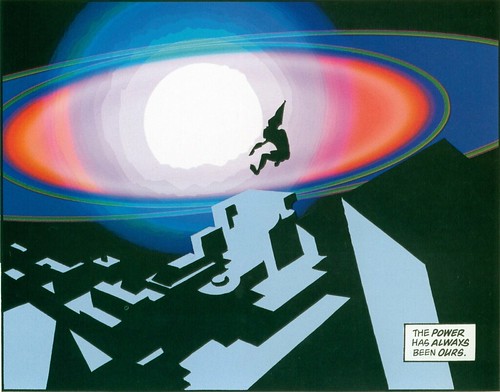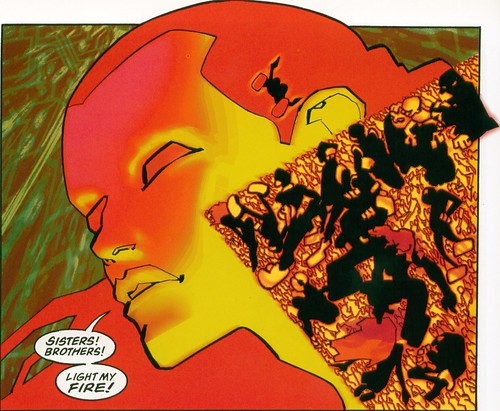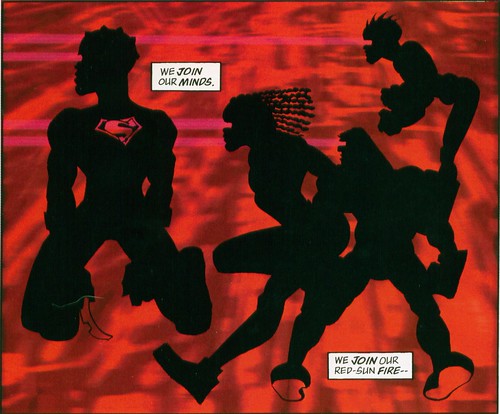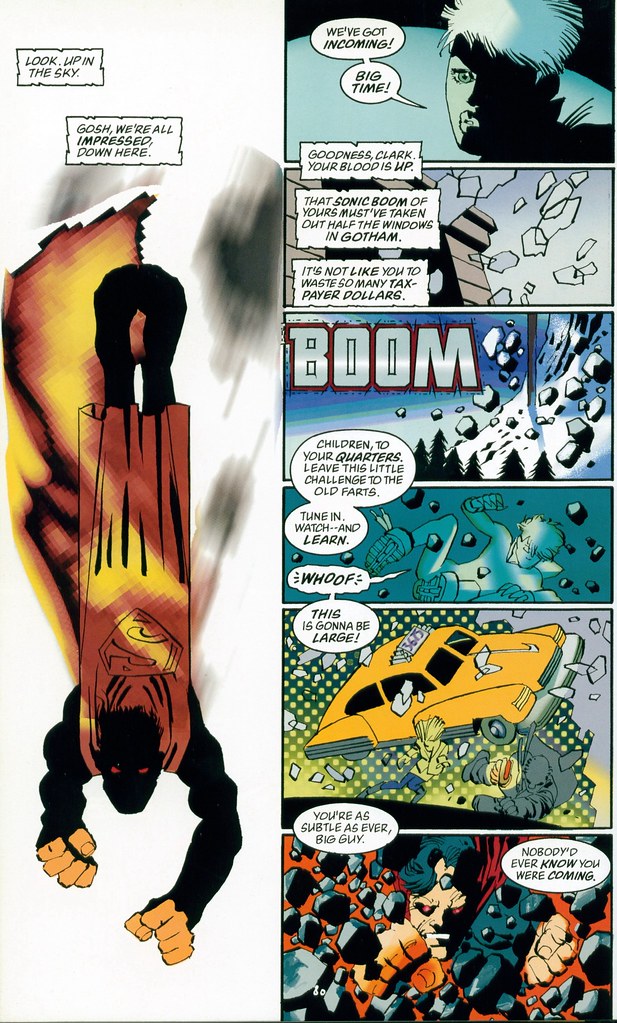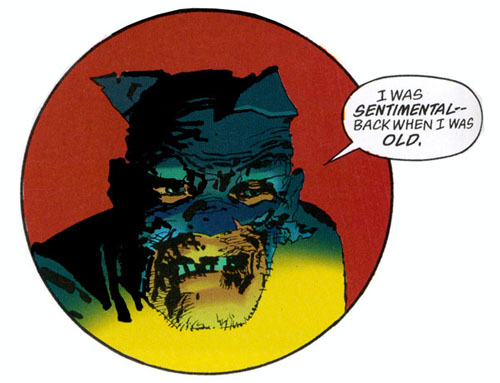Posts Tagged ‘Frank Miller’
“Daredevil” thoughts, Season One, Episode Seven: “Stick”
April 23, 2015…But the biggest and funniest riff [“Stick”] played off the Daredevil comics involves the title character himself. Played by the wonderful Scott Glenn — who between this and his similarly weird role on HBO’s The Leftovers appears not so much to have aged with time but dried out like beef jerky — Stick was the martial-arts mentor who transformed Matt Murdock from a blind kid with uncontrollably sensitive senses into the black-clad badass we know and love today. As such, he’s given to a lot of portentous pronouncements: “You’ll need skills for the war,” “Surrounding yourself with soft stuff isn’t life, it’s death,” “They’re gonna suffer and you’re gonna die,” etc. In other words, he’s not a man, he’s a Frank Miller comic in human form.
Miller was just a kid trying to make his way as a comics artist in the Taxi Driver-esque mean streets of Carter-era New York City (he was mugged twice) when he parlayed a shot at the low-selling Daredevil comic into superstardom. It was he who gave the series its neo-noir makeover, incorporating techniques gleaned from American comics pioneers like Will Eisner as well as manga, Japan’s homegrown comics scene which at the time had very little readership in the West. His interest in ninjas, which he made a core component of Daredevil’s backstory, more or less singlehandedly shoved the concept into the American pop-culture mainstream: The ninja-heavy G.I. Joe characters and comics that Marvel developed owe him a great deal, and the Teenage Mutant Ninja Turtles were conceived as a straight-up Daredevil parody. (Ever wonder why the Turtles’ sensei was called “Splinter”? If you’ve met “Stick,” you know the answer.)
As time went on, Miller gave Batman an even more successful grim and gritty makeover in his seminal work The Dark Knight Returns, to which the Tim Burton and Chris Nolan movie franchises owe a massive debt. He also created series of his very own, like the hardboiled crime comic Sin City and the homoerotic historical fantasia 300, both of which became hit films. Meanwhile, Miller himself became more and more like a grizzled old hardass from one of his own comics, wearing a fedora and reminiscing favorably about the good old days when America’s heroes were of the two-fisted, square-jawed variety. So when wrinkly, stubbly old Stick compares Matt Murdock to the Spartans, “the baddest of the badasses,” it’s a 300 reference that winks as much at Miller himself as the comic in question. This helps keep his zen tough-guy routine on the show just this side of knowing self-parody, instead of the unwitting kind.
I reviewed episode 7 of Daredevil, and wrote a lot about Frank “The Tank” Miller, for Decider.
Comics Time: The Dark Knight Strikes Again
February 14, 2011The Dark Knight Strikes Again
Frank Miller, writer/artist
Lynn Varley, colorist
DC, 2003
256 pages
$19.99
Buy it from Amazon.com
Originally posted on October 28, 2009 at The Savage Critic(s).
Years ago I came across an eye-opening quote from Jaron Lanier in the liner notes of the reissued Gary Numan album The Pleasure Principle. Google reveals that it was pulled from this Wired essay. Here’s what it said:
“Style used to be, in part, a record of the technological limitations of the media of each period. The sound of The Beatles was the sound of what you could do if you pushed a ’60s-era recording studio absolutely as far as it could go. Artists long for limitations; excessive freedom casts us into a vacuum. We are vulnerable to becoming jittery and aimless, like children with nothing to do. That is why narrow simulations of ‘vintage’ music synthesizers are hotter right now than more flexible and powerful machines. Digital artists also face constraints in their tools, of course, but often these constraints are so distant, scattered, and rapidly changing that they can’t be pushed against in a sustained way.”
Lanier wrote that in 1997. I’m actually not sure which vintage-synth resurgence he was talking about, unless you count the Rentals or something (although everyone and their grandfather was namechecking Gary Numan back then, which was sort of the point of including the quote in the liner notes. Maybe he meant Boards of Canada?).
But golly, it sure seems prescient now, huh? Here we are, in the post-electroclash, post-Neptunes, post-DFA era. The hot indie-rock microgenre is glo-fi, which sounds like playing a cassette of your favorite shiny happy pop song when you were three years old after it’s sat in the sun-cooked tape deck of your mom’s Buick for about 20 years. And my single favorite musical moment of last year, as harrowing as those songs are soothing, was the part of the universally acclaimed Portishead comeback album that sounded exactly like something from a John Carpenter film score. (It’s at the 3:51 mark. It’s awesome, isn’t it?)
And that’s just on the music end. Visually? Take a look at Heavy Light, a show at the Deitch Gallery this summer featuring a murderers’ row of video artist specializing in primary-color overload and technique that doesn’t just accentuate but revels in its own limitations. Foremost among them, at least for us comics folks, is Ben Jones, member of the hugely influential underground collective Paper Rad and recent reinterpreter of the massively mainstream The Simpsons and Where the Wild Things Are. But the ones with the widest cultural import at the moment are Tim Heidecker and Eric Wareheim of the astonishingly funny and bizarre Adult Swim series Tim & Eric Awesome Show, Great Job!. Their color palette is garish, their digital manipulations are knowingly crude, and their analog experiments are even more so. When they combine the three, god help us all. And let’s not forget Wareheim’s unforgettable, magisterially NSFW collaboration with fellow Heavy Light contributor and Gary Panter collaborator Devin Flynn.
Yeah, most of these guys are playing it either for laughs or for sheer mind-melting overload, but I think there’s frequently beauty in there to rival what some of the musicians are doing. (Click again on that first Ben Jones link.) And (thank you Internet God) this amazing video by Peppermelon shows that you can do action, awe, even sensuality with this aesthetic. The rawness, the brightness, the willingness to let the seams show–it all gives you something to push against again.
When I’ve written about The Dark Knight Strikes Again I’ve been fond of saying it was years ahead of its time. Sometime in the past week and a half or so, there was a day when I listened to Washed Out, then stumbled across that Deitch show link in an old bookmark, then watched an episode of Tim & Eric, then came across that Ben Jones WTWTA strip–and suddenly I realized I was right! Not that it matters–at all–whether or not Miller and Varley have any real continuity with any of this material. They certainly didn’t get there before Paper Rad, unless I’m wildly mistaken. But then half the fun of DKSA is spotting all the stuff Miller does, from naked newscasters to superheroes ruling the earth rather than just guarding it, seemingly without realizing someone’s done it first. What difference would that make? Meanwhile, in all the off-the-beaten-path references Frank Santoro has cited during the production of his Ben Jones collaboration Cold Heat–essentially a glo-fi comic book–I haven’t heard word one about this book. But I’m not saying Miller & Varley paved the way for anything. I’m saying that when Miller abandoned his chops (and, for the most part, backgrounds!) for the down and dirty styles he (thought he) saw at SPX, and when Varley decided to use photoshop to call attention to itself rather than to create a simulacrum of something else, they were using the same tools, tapping the same vein, seeking the same sense of excitement, discovery, and trailblazing as these newer movements.
I’ve also been fond of likening DKSA to proto-punk, taking a cue from Tony Millionaire’s jacket-wrap blurb: “Miller has done for comics what the Ramones et al have done for music. This book looks like it was done by a guy with a pen and his girlfriend on an iMac.” The idea is that it’s raw, it’s loud, it’s brash, it doesn’t have time for the usual niceties–it’s getting comics back to their primal pulp roots. I spoke to Miller several times during and following the release of the book, one time for print, and he said as much. (I certainly never would have bought the cockamamie idea that this thing was some sort of corporate cash-grab even if he’d never said word one.) He even mentioned to me his belief that the brightly colored costumes of the early superheroes served mainly the dual purpose of a) telling them apart from one another, and b) proving they weren’t naked, so even his thinking in historical terms had him ready to peel back from realism as a form of reclamation. And of course it’s not exactly like the story was at all subtle in this regard: Batman and his army came back to overthrow the dictators that kept us fat and happy and turned the superheroes into boring wimps. But ultimately the punk comparisons were just a little off. Born less of despair than of delight, filled less with anger than with joy, The Dark Knight Strikes Again anticipated a way of doing things that is not intended to look or sound effortless, that draws attention to its own construction, but which–with every pixelization and artifact, with every crayolafied visual and left-in glitch, with every burbly synth and sky-bright color–pushes against that construction and springs out into something wild and wonderful.


